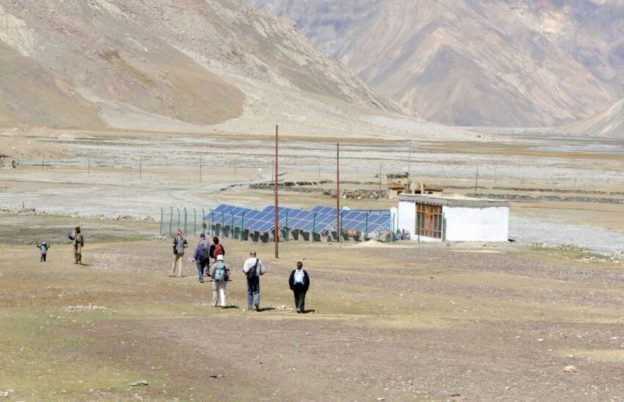India wants to become a leader in green hydrogen production and to develop huge solar projects in the Ladakh region of the Himalayas
The Indian government has pledged to invest $4.3 billion in green technology to clean up the country’s economy and create jobs.
In the announcement, Indian authorities included a focus on solar power from the Himalayan region of Ladakh and green hydrogen production.
Announcing her government’s annual budget today, finance minister Nirmala Sitharaman told parliament: “We are implementing many programmes for green fuel, green energy, green farming, green mobility, green buildings, and green equipment, and policies for efficient use of energy”.
“These green growth efforts help in reducing carbon intensity of the economy and provides for largescale green job opportunities,” she added.
The announcement comes after the US has approved a $500 billion green spending package to curb climate emissions and Japan layed out a plan to issue $150 billion in “green transition” bonds. The EU unveiled this month its own $270 billion plan to subsidize Europe’s green industry.
Despite its low per-person emissions, India’s huge population makes it the third-biggest emitter in the world. The country has pledged to reach net zero by 2070.
Green electricity
The government promised to invest 350 billion rupees ($4.3 bn) in investments towards the country’s energy transition and its net zero target.
The petroleum and natural gas ministry will oversee investments, Sitharaman told a press conference, adding they would include investments in gas.
The government will subsidise private-sector projects for battery energy storage. This technology can store electricity from intermittent power sources like renewables so that it can be used when the sun isn’t shining or the wind isn’t blowing.
Taiwan’s failure to clean up industry endangers its net zero pledge
The government said it will also look into pumped storage, a way to store energy using hydropower. When electricity is abundant, it is used to pump water up into a dam. When demand surges, the water can be released, producing hydro-electricity.
Sitharaman pledged to invest 83 bn rupees ($1 bn) of central government money in electricity transmission lines which can take 13 gigawatts (GW) of renewable electricity from the sunny, sparsely-populated Himalayan mountain state of Ladakh to population centres in the rest of the country. India aims to develop 500 GW of renewable energy capacity by 2030.
This echoes similar projects in neighbouring China, where renewable electricity is produced in the Gobi desert and transported to big cities in the east. In the US, construction has just started on a transmission line linking Arizona’s desert to California’s metropolises.
Green hydrogen
The budget touted the recently-launched national green hydrogen mission. The government will spend 197bn rupees ($2.4 bn) developing the carbon-free-fuel, which can replace fossil fuels in the manufacture of steel and in shipping and aviation.
Most of the money will be spent on incentives to produce hydrogen with renewable electricity and to build Indian electrolysers, the machines which turn water into hydrogen.
Sitharaman called green hydrogen a “sunrise sector” and said she wants India to “assume technology and market leadership” and reduce dependence on fossil fuel imports.
Azerbaijan weaponises conservation law in conflict with Armenia
India aims to produce five million metric tons by 2030. The International Energy Agency (IEA) has said that, for the world to limit global warming to 1.5C, it should produce about 100m metric tons of green hydrogen by 2030.
“The green hydrogen target is encouraging since it sends the right signals to the industry. We need to build the domestic capacity and supply chain on [renewable energy],” the IEA’s lead India analyst Swati D’Souza told Climate Home.
Adapting to climate change
Sitharaman announced money to adapt to the effects of climate change too. She promised 53bn rupees ($646m) to build irrigation systems for farming and drinking water in the drought-prone region of Karnataka.
She promised to plant mangrove trees along India’s shorelines and to restore wetlands. These can suck in and lock up greenhouse gases and help reduce flooding.
But Climate Action Network campaigner Harjeet Singh said that while there were good emissions-cutting projects, adapting to climate change had been mostly left out.
In particular, he criticised the lack of a new allocation to the National Adaptation Fund. This was set up in 2015 and “has been starved of funds”, he said.
Mixed messages on transport
The government promised money to both clean and polluting transport forms. The railway budget was the highest it has ever been and Sitharaman said she would promote coastal shipping as an “energy efficient” way of moving people and goods.
But she also promised to revive 50 airports, helipads or other types of landing grounds “to improve regional air connectivity”.
The Indian government is trying to build a domestic electric vehicle (EVs) industry. Sitharaman increased the custom duty on fully imported EVs from 60% to 70%.
At the same time, she increased spending on incentivising the manufacture of EVs in India and promised “adequate funds” to scrap old polluting government vehicles like ambulances.





